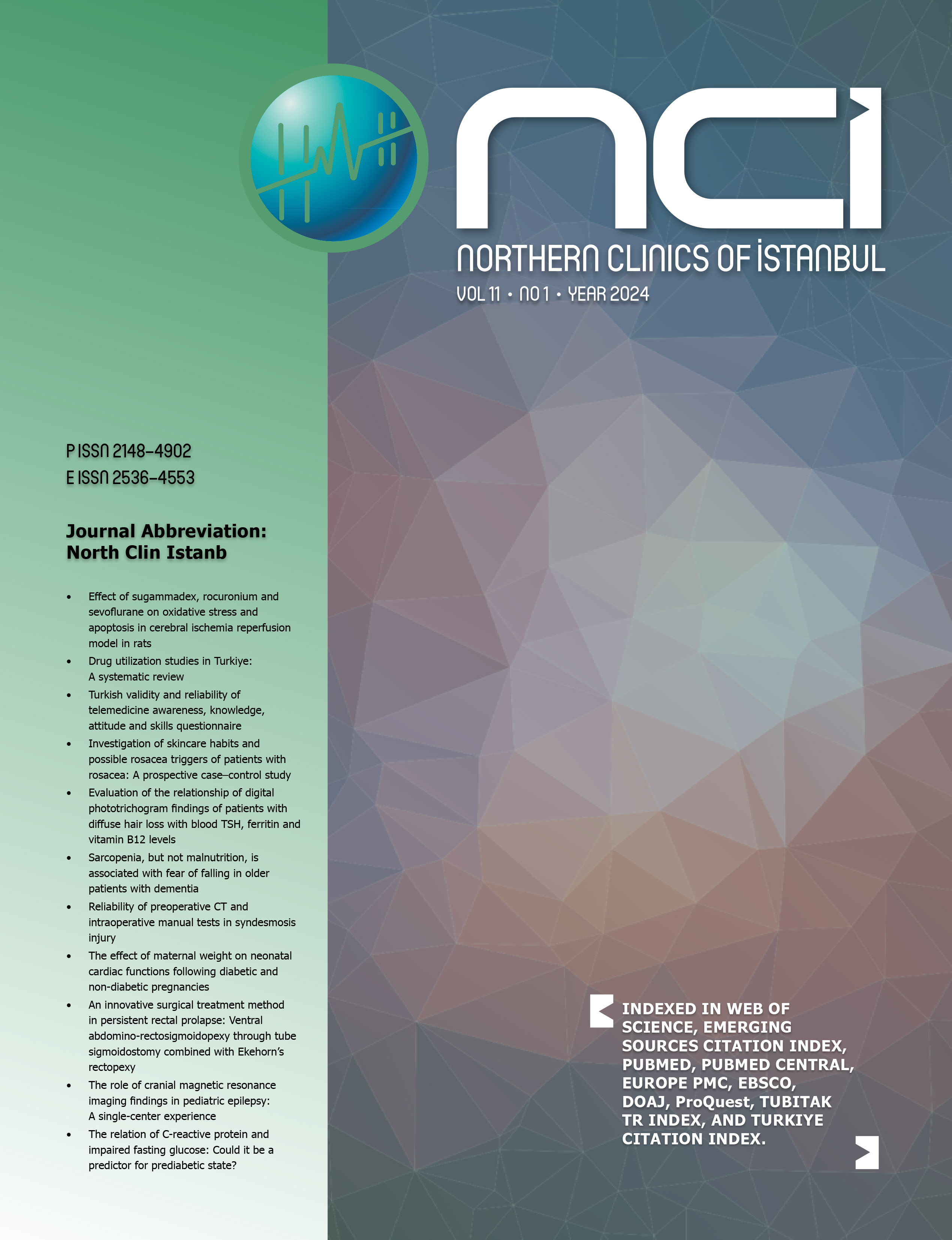Impact of stroke etiology on clinical symptoms and functional status
Özge Gülsüm Memetoğlu, Aslıhan Taraktaş, Naciye Bilgin Badur, Feyza Ünlü ÖzkanFatih Sultan Mehmet Training And Research Hospital, Department Of Physical Treatment And Rehabilitation. Istanbul.OBJECTIVE: The aim of this study is to investigate the differences between hemorrhagic and ischemic stroke
patients in terms of clinical and functional features.
METHODS: Medical records of the patients with stroke were analyzed retrospectively. The patients demographic characteristics, stroke etiology, time interval after the event, comorbid illness and functional status were recorded.
RESULTS: The stroke etiology was ischemia for 60 (36 male/24 female) (75%) patients, and haemorrhage for 20 (10 male/10 female) (25%) patients. Patients with ischemic stroke were classified as Group 1, and patients with hemorrhagic stroke were classified as Group 2. The mean age for Group 1 was 62.2±13.2, and 55.8±17.1 years for Group 2 (p=0.592). In Group 1, 33 (55%) patients, and in Group 2, 11 (55%) patients were primary school graduates (p=0.984). Localization of the lesion was in the right side for 33 (55%) patients in Group 1, and for 15 (75%) patients in Group 2 (p=0.372). The mean time interval after event for Group 1 was 7 months (0-211 days), and for Group 2 it was 14.5 (1-420 days) months (p=0.592). FIM score for Group 1 was 71.9±28.0, and 68.1±21.0 for Group 2 (p=0.575). The mean Brunnstrom score for upper extremity was 3.5 for Group 1, 3 for Group 2, (p=0.866), and for lower extremity, it was 3.5 for Group 1, and 3 for Group 2 (p=0.143). Spasticity was present in 45 (75%) patients in Group 1, and in 12 (60%) patients in Group 2 (p=0.311). In Group 1 51 (85%) of the patients and 18 (95%) patients had a history of comorbid disease (p=0.554).
CONCLUSION: Etiology of stroke is thought to be not effective on the patients clinical and functional status.
İnme Etiyolojisinin Klinik Bulgular ve Fonksiyonel Duruma Etkisi
Özge Gülsüm Memetoğlu, Aslıhan Taraktaş, Naciye Bilgin Badur, Feyza Ünlü ÖzkanFatih Sultan Mehmet Eğitim Araştırma Hastanesi, Fiziksel Tıp Ve Rehabilitasyon Bölümü. İstanbul.AMAÇ: Bu çalışmanın amacı hemorajik ve iskemik inmeli hastalar arasında klinik özellikleri ve fonksiyonel düzeyleri açısından fark olup olmadığını araştırmaktır.
YÖNTEMLER: İnmeli hastaların dosyaları retrospektif olarak incelendi. Demografik özellikleri, inme etiyolojisi, olay üzerinden geçen zaman, komorbid hastalıklar ve fonksiyonel durumları kaydedildi.
BULGULAR: Hastaların 60ı (36 erkek/24 kadın) (%75) iskemik, 20si (10 erkek/10 kadın) (%25) hemorajik kökenli inme idi. İskemik inmeli hastalar Grup 1, hemorajik kökenli inme hastalar Grup 2 olarak nitelendirildi. Ortalama yaş; Grup 1de 62.2±13.2 yıl, Grup 2de 55.8±17.1yıl (p=0.592) idi. Grup 1 de 33 (%55) hasta, Grup 2de 11 (%55) hasta ilkokul mezunuydu (p=0.984). Lezyon lokalizasyonu Grup 1de 33 (%55), Grup 2de 15 (%75) sağ taraftaydı (p= 0.372). Olayın üzerinden Grup 1 de 7 (0-211), Grup 2de 14.5 (1-420) ay geçmişti (p=0.592). FIM skoru Grup 1de 71.9±28.0, Grup 2de 68.1±21.0 (p=0.575) idi. Ortalama brunnstrom evresi üst ekstremitede; Grup-1de 3.5, Grup-2de 3 (p=0.866), alt ekstremitede Grup 1de 3.5, Grup 2de 3 (p=0.143) idi. Spastisite Grup 1de 45 (%75), Grup-2de 12 (%60) hastada mevcuttu (p=0.311). Hastaların Grup 1de 51inde (%85), Grup 2de 18sinde (%95) komorbid hastalık öyküsü vardı (p=0.554).
SONUÇ: İnme etiyolojisinin hastanın kliniği ve fonksiyonel düzeyi üzerine etkili olmadığı düşünülmüştür.
Corresponding Author: Özge Gülsüm Memetoğlu, Türkiye
Manuscript Language: Turkish






















